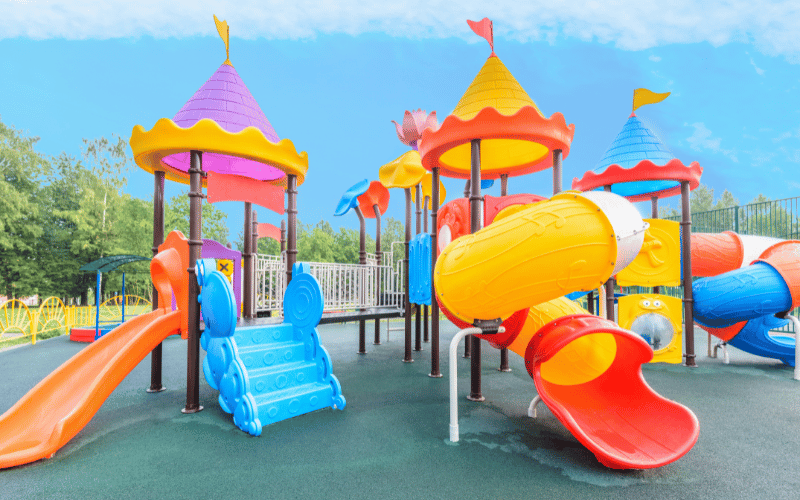Durable outdoor playgrounds ensure safety, save costs, and enhance community value. This guide offers material tips, maintenance strategies, and future-proofing advice to help you create a lasting play space.
Table of Contents
ToggleI. Understanding Durability in Playground Design
Durability in playground design isn’t just a feature—it’s the backbone of a safe, cost-effective, and beloved play space. A truly durable playground doesn’t just survive; it thrives, standing strong against the elements, heavy use, and the test of time. Let’s break down what makes a playground durable, why longevity matters, and the challenges you’ll need to address to keep your play area in top shape.
What Makes a Playground Durable?
Durability starts with the materials you choose. High-quality materials like powder-coated steel, UV-stabilized plastics, and rot-resistant wood form the foundation of a long-lasting playground. For surfacing, options like poured-in-place rubber or rubber tiles offer excellent weather resistance and wear durability, while engineered wood fiber requires more upkeep but can still perform well with proper maintenance.
Weather resistance is another critical factor. Materials must withstand everything from scorching sun to freezing temperatures without cracking, warping, or fading. For example, UV-stabilized plastics resist sun damage, while galvanized steel coatings prevent rust in humid or coastal environments.
Proper maintenance ties it all together. Even the best materials need regular care to stay durable. Loose-fill surfacing like wood chips requires consistent raking and topping off, while unitary surfaces like rubber tiles benefit from periodic cleaning and inspections for damage. Think of maintenance as the glue that holds durability together—it ensures your playground materials perform as intended for years to come.
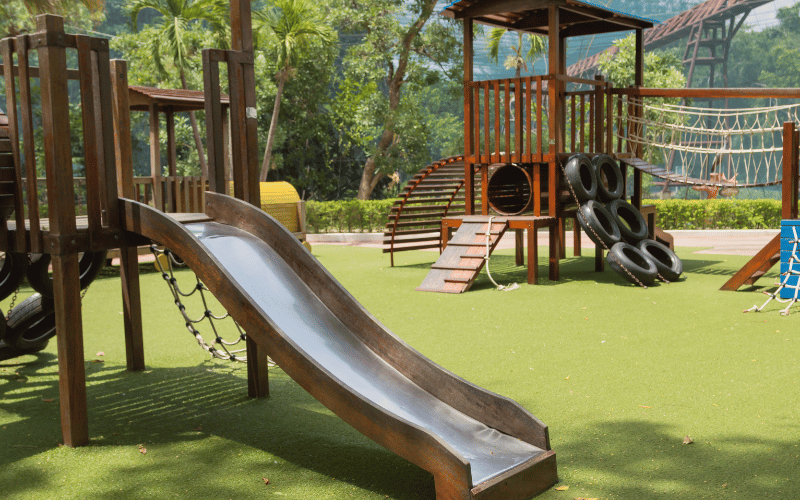
Benefits of Longevity
A durable playground delivers benefits that ripple through your community. First and foremost, it enhances safety. Materials that resist wear and tear maintain their structural integrity, reducing the risk of injuries caused by broken equipment or uneven surfaces.
Longevity also saves money. While high-quality materials may cost more upfront, they reduce long-term expenses by minimizing repairs and replacements. For example, investing in poured-in-place rubber surfacing may seem costly initially, but its durability and low maintenance needs make it a cost-efficient choice over time.
Ultimately, a well-maintained playground fosters community satisfaction. Families appreciate a well-maintained play space that feels safe and inviting, and they’re more likely to return and recommend it to others. A durable playground becomes a cherished part of the neighborhood, fostering connections and memories for generations.
Common Challenges
Durability doesn’t come without its challenges. Heavy usage is one of the most significant wear factors, especially in high-traffic areas like swings, slides, and climbing structures. These zones require materials that can handle constant impact and friction, such as reinforced steel chains or high-density polyethylene (HDPE) panels.
The weather is another formidable opponent. Rain, snow, and UV exposure can degrade materials over time, leading to rust, fading, or cracking. To combat this, choose weather-resistant finishes and schedule regular inspections to catch early signs of damage.
Vandalism poses a unique challenge, particularly in public playgrounds. Graffiti, broken equipment, or displaced surfacing can compromise both safety and aesthetics. Installing durable materials like anti-graffiti coatings on panels or tamper-resistant hardware can deter vandalism and make repairs easier when incidents occur.
So, understanding durability in playground design means looking beyond the surface. It’s about choosing the right materials, planning for maintenance, and addressing challenges head-on. A durable playground isn’t just a structure—it’s a promise to your community, ensuring children have a safe, enjoyable space to play for years to come.
II. Choosing the Right Site and Materials
Designing a playground is like crafting a masterpiece—every detail matters, from where you place it to the materials you use. The right site and materials don’t just shape the playground’s appearance; they determine its safety, longevity, and overall success. Let’s dive into the specifics of site selection and material choices to ensure your playground stands the test of time.
Site Selection
The location of your playground sets the stage for its functionality and appeal. Start by evaluating sun exposure and shade. A playground that bakes in the sun all day can make equipment and surfacing uncomfortably hot, especially in warmer climates. Incorporate natural shade from trees or install shade structures over high-use areas like slides and swings to keep the space cool and inviting.
Drainage is another critical factor. Poor drainage can lead to puddles, slippery surfaces, and long-term damage to equipment and surfacing. Choose a site with natural slopes or install a drainage system to direct water away from the play area. For example, adding a layer of crushed stone beneath engineered wood fiber can improve drainage and prevent pooling.
Don’t overlook accessibility and safety buffers. Ensure the site is easy to reach for children of all abilities by including ADA-compliant pathways and ramps. Surround the play area with safety zones, such as open spaces or fencing, to create a buffer from nearby roads, parking lots, or other hazards. A well-chosen site acts as the foundation for a playground that’s safe, inclusive, and enjoyable.
Material Selection
The materials you choose are the building blocks of your playground’s durability and performance. Each material brings its own strengths, and selecting the right ones ensures your playground can handle the demands of play and weather.
Wood offers a classic, natural aesthetic, but not all wood is created equal. Opt for treated lumber to resist rot and insects, or choose naturally rot-resistant species like cedar or redwood for a more eco-friendly option. Seal wood components regularly to protect them from moisture and UV damage, and inspect for splinters or cracks that could pose safety risks.
Metal is a powerhouse of strength and durability, but it requires careful selection to prevent rust and wear. Galvanized steel is a popular choice for its corrosion resistance, while stainless steel offers a sleek, rust-proof finish for high-end designs. For lightweight applications, aluminum provides excellent resistance to rust and is easy to work with. To prevent burns, coat metal surfaces with heat-resistant finishes, especially in sunny climates.
Plastics have become a playground staple for their versatility and safety. Choose recycled HDPE (high-density polyethylene) for eco-friendly panels and components that resist fading and cracking. Rotomolded plastics are another excellent option, offering seamless, durable designs for slides, tunnels, and climbers. Always verify that plastics are UV-stabilized to withstand prolonged sun exposure without degrading.
Surfacing is the unsung hero of playground safety, cushioning falls and enhancing accessibility. Engineered wood fiber (EWF) is a cost-effective option that provides good impact absorption when maintained at the proper depth. For a more durable and low-maintenance solution, consider rubber tiles or poured-in-place rubber, both of which offer excellent shock absorption and ADA compliance. Poured-in-place rubber can even be customized with colors and patterns to match your playground’s theme.
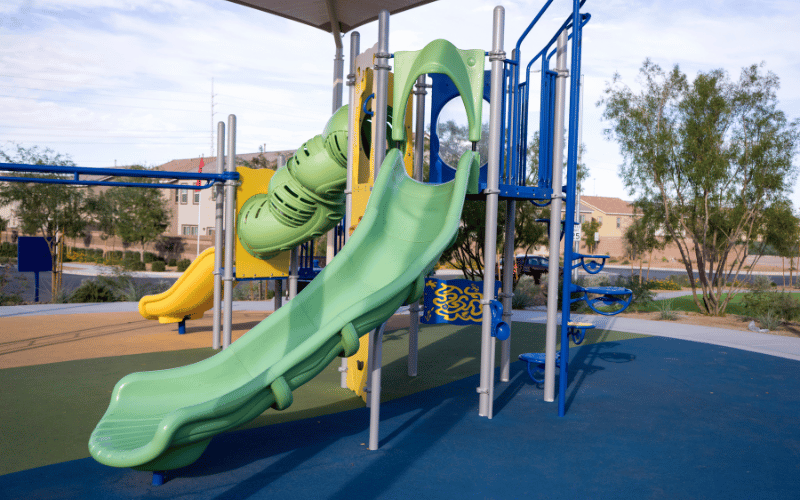
Bringing It All Together
Choosing the right site and materials is about more than just aesthetics—it’s about creating a playground that’s safe, durable, and welcoming for all. By carefully considering factors like sun exposure, drainage, and material quality, you can design a play space that not only meets today’s needs but also stands strong for years to come. Every decision, from the ground beneath to the shade above, contributes to a playground that children and families will cherish.
III. Designing for Durability and Reduced Wear
A well-designed playground doesn’t just invite play—it anticipates the challenges of time, weather, and constant use. Thoughtful design choices can significantly reduce wear and tear, ensuring your playground remains safe, functional, and visually appealing for years. Let’s explore how smart layouts, shading, age-appropriate zones, and strategic planning can make all the difference.
Smart Layouts
A playground’s layout is like a roadmap for play, guiding children naturally through the space while minimizing congestion and wear. Start by identifying high-traffic areas, such as entrances, slides, and swings. These zones endure the most use, so reinforce them with durable surfacing like poured-in-place rubber or rubber tiles. For loose-fill materials like engineered wood fiber, ensure proper depth and containment to handle the constant impact.
Plan for natural flow by creating clear pathways between play zones. For example, position climbing structures away from swings to prevent bottlenecks and collisions. Use landscaping or low barriers to subtly guide movement and keep children from cutting across sensitive areas, like flower beds or drainage zones. A well-thought-out layout not only reduces wear but also enhances safety and play value.
Shading Solutions
Sun exposure can take a toll on both equipment and users, making shading an essential part of durable playground design. Shade sails and structures are versatile options that can be installed over high-use areas like slides, climbers, and seating zones. These solutions protect children from UV rays while preventing equipment from becoming too hot to touch.
For a natural approach, incorporate trees into your design. Strategically planted trees provide shade, improve aesthetics, and even help with temperature regulation. Choose hardy, non-toxic species like oak or maple, and position them to cast shade during peak sun hours. Just be mindful of root systems, which can disrupt surfacing if planted too close to play areas.
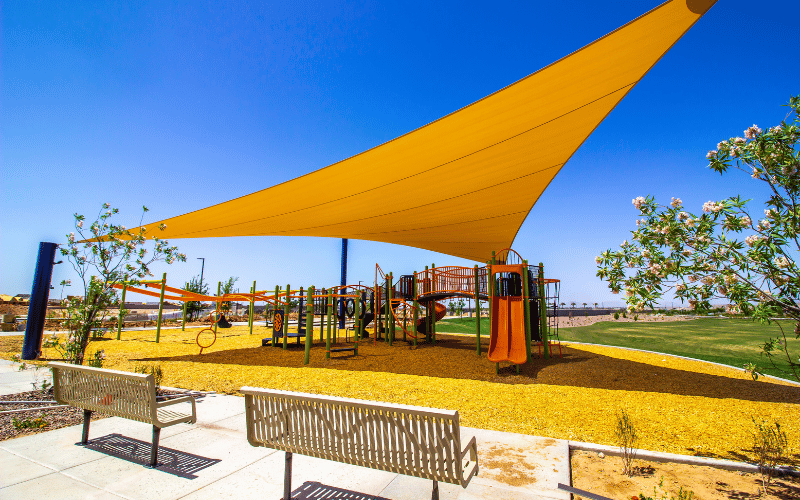
Age-Appropriate Zones
Catering to diverse age groups not only enhances inclusivity but also distributes wear across the playground. Create age-appropriate zones with equipment tailored to different developmental stages. For example, designate a toddler area with low platforms, sensory panels, and soft surfacing, while reserving taller climbers and dynamic equipment like zip lines for older children.
By separating play zones, you reduce the likelihood of overcrowding and uneven wear. Younger children won’t feel overwhelmed by older kids, and high-energy activities won’t interfere with quieter, imaginative play. This thoughtful zoning ensures every child has a space to enjoy while extending the lifespan of your equipment and surfacing.
Avoiding Weak Points
Weak points in playground design often lead to premature wear and safety concerns. Pinch points, such as narrow gaps between moving parts, can cause damage to equipment and pose risks to children. Opt for designs with smooth, rounded edges and tamper-resistant hardware to eliminate these vulnerabilities.
Confined spaces are another common issue. Tight corners or enclosed areas can trap debris, moisture, and even pests, accelerating wear and creating maintenance headaches. For example, avoid placing equipment too close to fences or walls, and ensure proper spacing between structures to allow for easy cleaning and inspections.
Bringing It All Together
Designing for durability and reduced wear requires a proactive approach. By planning smart layouts, incorporating shading, creating age-appropriate zones, and addressing potential weak points, you build a playground that thrives under the demands of play. Every design choice should work in harmony to protect your investment and provide a safe, enjoyable space for children to explore. A durable playground isn’t just built—it’s thoughtfully crafted to endure.
IV. Installation Best Practices
The installation process is where all the planning, design, and material selection come to life. A well-installed playground isn’t just functional—it’s safe, durable, and built to perform as intended. Let’s explore the critical steps to ensure your playground is installed with precision and care.
Professional Installation
Playground installation is not a DIY project. It requires the expertise of certified installation teams who understand the nuances of safety standards, equipment specifications, and site preparation. These professionals ensure that every component is anchored securely, aligned properly, and installed according to the manufacturer’s guidelines.
For example, swings and climbers must be anchored deeply into the ground to prevent tipping or shifting over time. Loose or improperly secured equipment can lead to safety hazards and costly repairs. Certified teams use specialized tools and techniques, such as torque wrenches to tighten bolts to the correct specifications and laser levels to ensure even surfaces.
When hiring an installation team, verify their credentials and ask for references or examples of past projects. A skilled team doesn’t just assemble equipment—they bring your vision to life while prioritizing safety and compliance.
Quality Assurance
Quality assurance begins during installation, not after. Conduct early checks at key stages of the process to ensure everything aligns with the manufacturer’s guidelines and safety standards. For instance, measure the depth of footings before concrete is poured to confirm they meet the required specifications for stability.
Inspect bolts, fasteners, and connections as they’re installed. Loose or over-tightened hardware can compromise the integrity of the equipment. Use a checklist to verify that all components are present, properly secured, and free of defects.
Pay close attention to surfacing installation as well. For loose-fill materials like engineered wood fiber, ensure the correct depth is achieved and evenly distributed. For unitary surfaces like poured-in-place rubber, monitor the curing process to avoid uneven areas or weak spots.
Involve a Certified Playground Safety Inspector (CPSI) to review the installation before the playground opens to the public. Their trained eye can catch potential issues that might go unnoticed, giving you peace of mind that your playground meets all safety and compliance requirements.
A Foundation for Success
Proper installation is the cornerstone of a successful playground. By relying on certified professionals and conducting thorough quality checks, you ensure that your play area is safe, durable, and ready to welcome children for years to come. Every bolt tightened and every surface leveled contributes to a space where families can play with confidence and joy.
V. Maintenance and Repairs: Keeping Playgrounds Safe
A playground is like a living, breathing entity—it thrives when cared for and quickly shows signs of neglect when overlooked. Maintenance and repairs are the heartbeat of a safe and enjoyable play space, ensuring every swing, slide, and surface performs as intended. Let’s break down the essential steps to keep your playground in top condition.
Routine Inspections
Routine inspections are your first line of defense against potential hazards. Start with daily visual checks to spot obvious issues like debris, broken equipment, or displaced surfacing. For example, look for loose bolts on swings, cracks in slides, or areas where loose-fill surfacing has thinned out. These quick scans take minutes but can prevent accidents before they happen.
Move to weekly detailed inspections to dig deeper into the playground’s condition. Check fasteners, moving parts, and surfacing for signs of wear. For instance, inspect swing chains for rust or fraying, ensure bolts are tight and secure, and measure the depth of loose-fill materials to confirm they meet safety standards. Document your findings in a log to track recurring issues and plan maintenance schedules.
Schedule annual professional audits for a comprehensive safety review. Certified Playground Safety Inspectors (CPSIs) can identify hidden risks, such as structural weaknesses or non-compliance with updated safety standards. These audits provide a fresh set of eyes and ensure your playground remains a safe haven for children.
Proactive Repairs
Proactive repairs are the key to preventing minor issues from escalating into major problems. Address wear and tear as soon as you notice it. For example, replace a cracked plastic panel before it breaks completely or tighten a loose bolt before it causes structural instability.
When sourcing replacement parts, always use original or compatible components to maintain the integrity of the equipment. Avoid generic parts that may not meet the manufacturer’s specifications or safety standards. If a specific part is discontinued, consult the manufacturer or a certified installer for guidance on compatible alternatives.
Knowing when to repair versus replace equipment is crucial. Minor issues like a worn swing seat or a loose handrail can often be repaired quickly and cost-effectively. However, if a piece of equipment shows extensive rust, structural damage, or repeated failures, replacement may be the safer and more economical choice in the long run. For example, a heavily corroded metal climber may no longer meet safety standards, even with repairs, and should be replaced to ensure children’s safety.
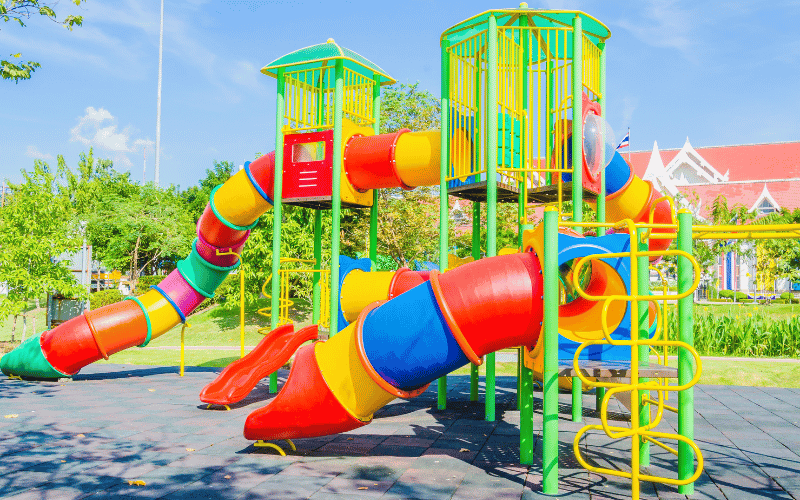
A Commitment to Safety
Maintenance and repairs are not just tasks—they’re a commitment to the children and families who rely on your playground. By conducting regular inspections, addressing issues proactively, and making informed decisions about repairs and replacements, you create a play space that’s safe, welcoming, and built to last. Every action you take reinforces the trust your community places in your playground, ensuring it remains a cherished destination for years to come.
VI. Preventing Vandalism and Misuse
A playground is more than just a collection of equipment—it’s a community asset, a space where children’s laughter fills the air. Protecting it from vandalism and misuse requires a proactive approach that combines thoughtful design, community involvement, and strategic security measures. Let’s explore how to safeguard your playground while maintaining its welcoming atmosphere.
Design Deterrents
The design of your playground can act as its first line of defense against vandalism. Start by incorporating smooth surfaces and durable materials that are harder to deface or damage. For example, opt for powder-coated steel or high-density polyethylene (HDPE) panels, which resist graffiti and are easy to clean. Anti-graffiti coatings can also be applied to vulnerable surfaces, making cleanup as simple as a quick wipe.
Visible layouts play a crucial role in deterring vandalism. A well-lit, open design with clear sightlines makes it harder for vandals to act unnoticed. Avoid creating hidden corners or enclosed spaces where damage can occur out of view. Position high-value equipment, like slides or climbers, in areas that are easily visible from nearby roads, homes, or community centers. A playground that feels exposed to watchful eyes is far less likely to become a target.
Community Involvement
Engaging the local community transforms a playground from a public space into a shared treasure. When people feel a sense of ownership, they’re more likely to protect and care for it. Start by involving residents in the planning and design process. Host community meetings, gather input on equipment choices, and even organize volunteer days for installation or landscaping.
Once the playground is operational, encourage ongoing community engagement. Organize events like family play days, cleanup drives, or seasonal celebrations to keep the space active and well-loved. Consider forming a “Friends of the Playground” group to oversee maintenance, report issues, and foster a sense of pride among local residents. A playground that feels like it belongs to the community is far less likely to suffer from vandalism or neglect.
Security Measures
While design and community involvement go a long way, some situations call for additional security measures. Start with lighting, which is one of the most effective deterrents. Install bright, energy-efficient LED lights around the playground to illuminate the area after dark. Focus on entrances, high-value equipment, and any potential hiding spots.
Signage can also discourage misuse by clearly outlining rules and expectations. For example, post signs that prohibit activities like skateboarding, littering, or after-hours use. Use friendly but firm language to communicate that the playground is a space for safe, respectful play.
In areas with persistent vandalism issues, consider adding surveillance. Motion-activated cameras or dummy cameras can act as a deterrent, especially when paired with visible signage indicating the area is monitored. If cameras aren’t an option, regular patrols by local law enforcement or community volunteers can achieve a similar effect.
Protecting What Matters
Preventing vandalism and misuse is about more than just protecting equipment—it’s about preserving the joy and safety that a playground brings to a community. By designing with deterrence in mind, fostering local involvement, and implementing strategic security measures, you create a space that’s not only resilient but also cherished. A well-protected playground becomes a symbol of community pride, standing strong as a place where children can play freely and families can gather with confidence.
VII. Future-Proofing Your Playground
A playground isn’t just built for today—it’s an investment in the future of your community. Future-proofing ensures your play space remains relevant, safe, and engaging as needs evolve. By focusing on adaptable designs, planning for change, and budgeting wisely, you can create a playground that grows alongside the children and families it serves.
Adaptable Designs
Flexibility is the cornerstone of a future-proof playground. Incorporate modular components that allow for easy upgrades or reconfigurations. For example, choose play structures with interchangeable panels or add-on features like climbing walls, sensory panels, or interactive games. This approach lets you refresh the playground without a complete overhaul, keeping it exciting and relevant for years to come.
Think about multi-functional spaces that can adapt to different activities. For instance, a large open area with durable surfacing can serve as a play zone today and host community events or fitness classes in the future. By designing with adaptability in mind, you ensure the playground remains a versatile asset for the community.
Planning for Change
The playground industry is constantly evolving, with new safety standards, materials, and play trends emerging regularly. Stay ahead by anticipating these changes during the planning phase. For example, monitor updates to ASTM and CPSC guidelines to ensure your playground meets or exceeds current safety requirements.
Keep an eye on emerging play trends, such as inclusive play equipment, nature-inspired designs, or interactive technology. While you don’t need to incorporate every trend, being aware of them allows you to make informed decisions about future upgrades. For instance, if inclusive play is gaining traction in your area, you might plan to add wheelchair-accessible ramps or sensory play panels in the next phase of development.
Budgeting for Longevity
Future-proofing isn’t just about design—it’s also about financial planning. Allocate funds for long-term maintenance to keep your playground in peak condition. For example, set aside a portion of your budget for resurfacing, repainting, or replacing worn components. Regular maintenance not only extends the life of your equipment but also reduces the likelihood of costly emergency repairs.
In addition to maintenance, budget for innovation and upgrades. Establish a reserve fund specifically for adding new features or updating existing ones as needs change. For instance, you might plan to replace traditional swings with adaptive swings or add a shaded seating area as the community grows. By planning financially for the future, you ensure your playground remains a vibrant and valuable resource.
Building for Tomorrow
Future-proofing your playground is about more than just keeping up with trends—it’s about creating a space that evolves with the community it serves. By designing for adaptability, planning for change, and budgeting with foresight, you build a playground that stands the test of time. Every decision you make today lays the foundation for a play space that continues to inspire joy, connection, and growth for generations to come.
VIII. Sustainability in Playground Design
A sustainable playground does more than provide a space for play—it becomes a teaching tool, a community asset, and a step toward a healthier planet. Designing with sustainability in mind means making choices that reduce environmental impact while enhancing the play experience. Let’s explore how eco-friendly materials, energy-efficient features, and educational opportunities can create a playground that’s as kind to the earth as it is to its users.
Eco-Friendly Materials
The materials you choose set the tone for sustainability. Start with recycled plastics, such as high-density polyethylene (HDPE), which can be used for panels, benches, and even play structures. These materials are not only durable and weather-resistant but also divert waste from landfills. For example, a single recycled plastic bench can save hundreds of milk jugs from being discarded.
For a natural aesthetic, opt for sustainably sourced wood like FSC-certified cedar or redwood. These woods are harvested responsibly, ensuring forests are preserved for future generations. Pair them with non-toxic, water-based finishes to protect the wood without introducing harmful chemicals into the environment.
Even surfacing can be eco-friendly. Consider poured-in-place rubber made from recycled tires or engineered wood fiber sourced from sustainable forestry practices. These options offer safety and durability while minimizing the environmental impact of your playground.
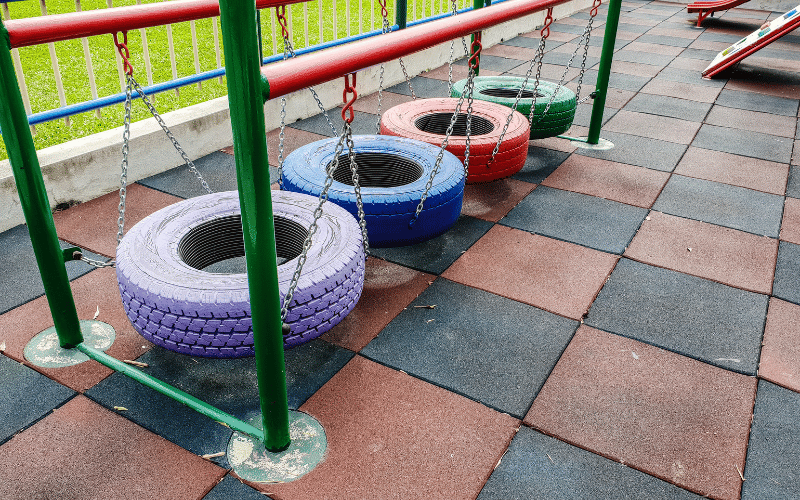
Energy-Efficient Features
Sustainability doesn’t stop at materials—it extends to the features that support your playground. Solar-powered lighting is an excellent addition, providing illumination for evening use without increasing energy consumption. Install solar panels on nearby poles or shade structures to power LED lights, creating a safe and eco-conscious environment.
For landscaping, incorporate water-saving irrigation systems like drip irrigation or rainwater harvesting. These systems deliver water directly to plant roots, minimizing waste and promoting healthy growth. Pair them with native or drought-resistant plants to further reduce water usage while enhancing the natural beauty of the playground.
Teaching Sustainability
A sustainable playground can also serve as an educational tool, inspiring children and families to care for the environment. Add educational signage that highlights the eco-friendly features of the playground. For example, a sign near a recycled plastic bench could explain how many bottles were repurposed to create it, while a plaque by a solar panel could describe how it powers the playground’s lights.
Interactive elements can take this a step further. Consider installing a rainwater collection system with a clear tank that shows how much water has been saved or a small garden where children can learn about native plants and pollinators. These features turn the playground into a living classroom, fostering environmental awareness and stewardship.
Designing for a Greener Future
Sustainability in playground design is about making thoughtful choices that benefit both the community and the planet. By using eco-friendly materials, incorporating energy-efficient features, and creating opportunities for education, you build a playground that not only supports play but also inspires a deeper connection to the environment. Every recycled panel, solar light, and educational sign contributes to a greener, more sustainable future for the next generation.
FAQs
Q: How often should an outdoor playground be inspected?
A: Conduct daily visual checks to spot obvious issues like debris, loose bolts, or damaged surfacing. Perform weekly detailed inspections to assess fasteners, moving parts, and surfacing depth. Schedule annual professional audits with a Certified Playground Safety Inspector (CPSI) to ensure compliance with safety standards and identify hidden risks. Regular inspections keep the playground safe and extend its lifespan.
Q: What are the most durable materials for outdoor playground equipment?
A: Galvanized steel, stainless steel, and aluminum offer excellent durability for structural components, resisting rust and wear. Recycled HDPE (high-density polyethylene) and rotomolded plastics work well for panels and slides, as they resist fading, cracking, and UV damage. For surfacing, poured-in-place rubber and rubber tiles provide long-lasting, low-maintenance options. Choose materials based on your climate and usage needs for the best results.
Q: Can old playground equipment be upgraded to meet current safety standards?
A: Yes, many older playgrounds can be upgraded. Start by replacing worn or outdated components, such as swing chains, fasteners, or surfacing, with modern, compliant materials. Add features like safety barriers, ADA-compliant ramps, or updated signage to meet current standards. Consult a Certified Playground Safety Inspector (CPSI) to assess the equipment and recommend upgrades that align with today’s safety guidelines.
Q: What steps can be taken to prevent vandalism on a community playground?
A: Design the playground with deterrents like smooth, graffiti-resistant surfaces and open layouts with clear sightlines. Install bright LED lighting to discourage after-hours activity and post clear signage outlining rules. Engage the community by hosting events and forming a “Friends of the Playground” group to foster a sense of ownership. In high-risk areas, consider adding surveillance cameras or increasing patrols to deter vandalism further.
Q: How does climate impact the lifespan of an outdoor playground?
A: Climate plays a significant role in a playground’s durability. In sunny regions, UV exposure can fade plastics and heat metal surfaces, so choose UV-stabilized materials and heat-resistant coatings. In wet or coastal areas, moisture and salt can cause rust, making galvanized or stainless steel essential. Freezing climates can lead to cracking in certain plastics and surfacing, so opt for materials designed to withstand temperature fluctuations. Regular maintenance tailored to your climate helps mitigate these effects and prolongs the playground’s lifespan.
Conclusion
Investing in durable outdoor playgrounds ensures safety, reduces long-term costs, and enhances community enjoyment. Take actionable steps today by choosing quality materials, planning for maintenance, and designing with longevity in mind to create play spaces that stand the test of time.




